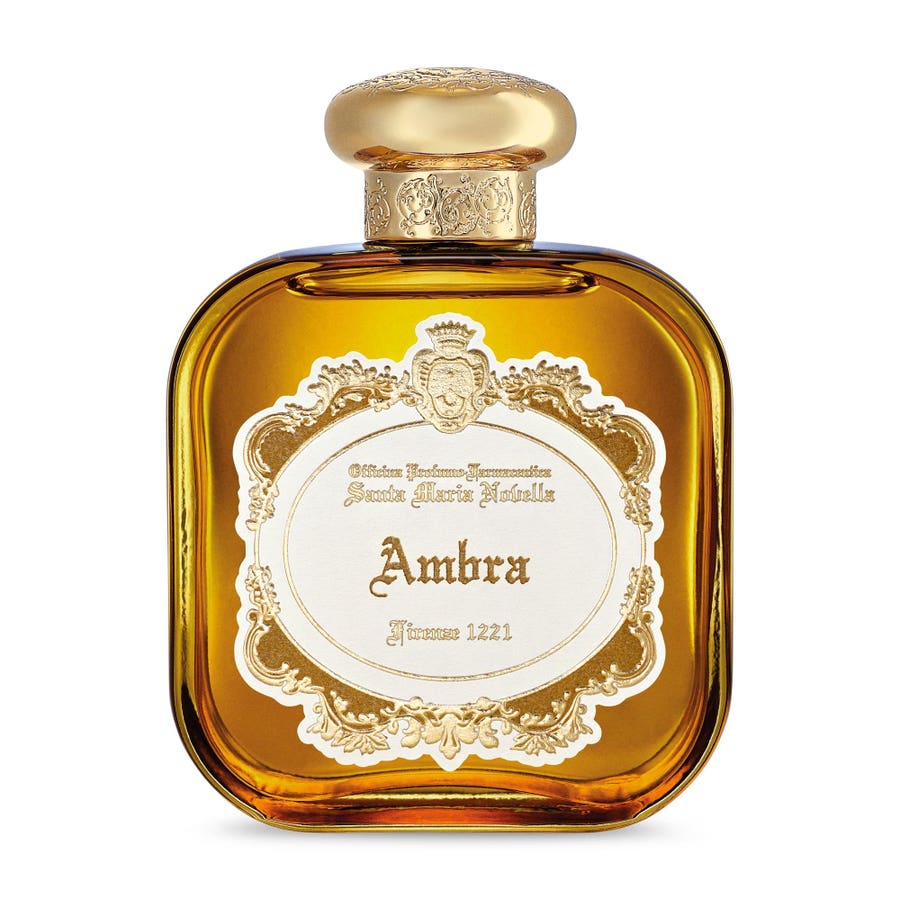Found in the heart of Florence, and carved out of a chapel dating back to 1221, Oficina Profumo-Farmaceutica di Santa Maria Novella is one of the oldest herbal pharmacies in the world and one of the Italian city’s must-visit sites. The destination is not just of historical interest—the brand’s roots lie with the therapeutic remedies once concocted by Dominican monks—but it stands as one of the cult (and beautiful) stores for the label’s coveted perfume and scented goods.
As well as Santa Maria Novella’s trademark soaps, laced with classic notes of gardenia and iris, and its original formula of Aqua di Rose (the rosewater was created in 1381 and used for cleansing during the plague), the shop is filled with beautifully designed bottles of fragrance—think: coloured glass flacons with gold stoppers and elaborate labels printed with Medieval-style fonts—that give a nod to the brand’s historical roots.
The new fragrance Ambra takes you to Renaissance Florence.
(Credit: Oficina Profumo-Farmaceutica di Santa Maria Novella)
From the oldest eau de cologne, Aqua della Regina (commissioned by Catherine de’ Medici in the 16th century and still sold today), to the Carta D’Armenia (scented paper you burn to fragrance a room), many of the items displayed on the walnut shelves might date back many years, but that’s not to say Santa Maria Novella has stopped innovating.
Ambra and Incenso are two new eau de parfums, released as part of the I Giardini Medicei Collection. This line-up of fragrances pays tribute to Renaissance Florence, a crossroads of cultures and scents from distant lands, and to the Medicean villas’ gardens, symbols of beauty, art, and nature.
Incenso Eau de Parfum guides us on a sensory journey through time and space.
(Credit: Oficina Profumo-Farmaceutica di Santa Maria Novella)
One spritz and you are immediately transported to this Florentine world of old. Ambra Eau de Parfum ($275 for 100ml) weaves the mystery of the East with the citrus fruits so beloved by the Medici family. Belonging to the oriental amber family, it evokes a winter garden in the Florentine court. Incenso Eau de Parfum ($275 for 100ml), meanwhile, is rooted in the spicy woody olfactory family, and celebrates incense as a universal symbol that combines resin, plant, and precious material together.
The new Eau Triple Ambre de Madagascar was inspired by a stroll through the Madagascan landscape at dawn.
(Credit: Officine Universelle Buly 1803)
Also transporting you to a bygone world of tradition, but this time via Paris, is the Officine Universelle Buly 1803 brand. Founded in 2014 by Ramdane Touhami and Victoire de Taillac-Touhami, Buly 1803 was a reimagination of an 18th century apothecary brand located in Paris and founded by Jean-Vincent Bully.
Like Santa Maria Novella, many items in the catalogue honour the original beauty recipes, while new formulas—such as the water-based perfumes, known as ‘eau triple’—are industry firsts. These scents, that contain 0% alcohol, have been inspired by far-flung lands and have at their hearts a blend of precious ingredients found there.
The new Officine Universelle Buly Eau Triple Ambre de Madagascar (€150 for 75ml), for example, was inspired by a stroll through the Madagascan landscape at dawn, where sunny mandarin trees and jasmine scent the air. The result is an intoxicating floral scent blended with heady amber.
Beija Flor Elasti-Body Oil scents the body and gives anti-ageing proeprties.
(Credit: Sol de Janeiro)
Transporting you to the shores of Brazil, on the other hand, is Sol de Janeiro, which came to fame in 2016 due to its now-iconic Brazilian Bum Bum Cream, scented with pistachio, salted caramel and vanilla. The company has since expanded into Instagram-friendly fragrances and a results-driven perfumed skincare line, including new body oils. The latest is the Beija Flor Elasti-Body Oil (£52 for 100ml), which can be matched with the Beija Flor Body Wash, Rio Deo Cheirosa 68 Deodorant and Cheirosa 68 Beija Flor Perfume Mist for layered fragrancing while on the go. Perfect for travellers, the anti-aging oil is made with retinol-mimicking cacay oil, nourishing squalane and amaranthus flowe extract that helps boost skin elasticity. The result is visibly plumper, bouncy, smoother-looking skin, all while you dream of time spent on Copacobana Beach.
Valaya Exclusif takes you to 18th century France.
(Credit: Parfums de Marly)
Valaya Exclusif by Parfums de Marly (£170 for 30ml) is the latest long-lasting parfum from the luxury French brand. A velvety twist on the brand’s Valaya Eau de Parfum, the new version blends almond, vanilla and white woods, and aims to emulate the feel of cotton against the skin. Its serene, white bottle has silver detailing that evokes the interplay of transparency and precious embroidery favored by 18th-century French noblewomen.
No 14 Iclia Eau de Parfum is inspired by a ‘seize the day’ ethos.
(Credit: Maison Louis Marie)
New from another French perfume house, Maison Louis Marie, is No 14 Iclia Eau de Parfum (£92 for 50ml). The brand came about as the result of a long, storied family history with scent and travel. it began with Louis Marie Aubert du Petit Thouars: a pioneer in French botanical history, he was exiled to Madagascar, La Reunion and the Mauritius islands during the French revolution. There, he discovered a vast array of plant specimens, collecting over 2,000 to bring back to France ten years later. Some 200 years on, Marie du Petit Thouars grew up in Belgium, playing in her grandfather’s nursery while making candles and experimenting with scents in her mother’s greenhouse. She eventually founded Maison Louis Marie: using the rich botanical history of her family as her inspiration.
Her new creation for 2025 was inspired by the French word ‘ici’, meaning ‘here’, and embodies the idea that every fleeting second is sacred. A warm floral fragrance, it has top notes of ruby pamplemousse, mandarin leaf, and jasmine. At its heart are dark plum and nectar, anchored by warm vanilla flowers and sakura blossoms to represent the act of simultaneously grounding and growing. A base of warm, sultry woods and sweet floral blossoms transport you to sunny climes.
Montabaco Aruba takes you straight to the Caribbean.
(Credit: Ormonde Jayne)
London based perfume brand, Ormonde Jayne’s latest parfum offering, Montabaco Aruba (£220 for 88ml), takes you straight to the Caribbean. The limited edition fragrance is a tribute to the island of Aruba with its sandalwood base and top notes of bergamot, orange absolute and grapefruit. The fragrance is zesty and bright, reminiscent of sun-drenched citrus groves.
The fragrance then opens into a floral bouquet of magnolia, jasmine, rose and violet, evoking the tropical blooms of the island. As the scent settles, more sensual notes emerge with an earthy richness of tobacco leaf and leather delicately spiced with cardamom. Finally, the signature ingredient, sandalore, transports the wearer to the sunlit shores of Aruba.
Clive Christian perfume are known for their fine quality and heritage background.
(Credit: Clive Christian)
Known for his opulent and storied creations, Clive Christian’s latest parfum, L Red Tea Vetiver (£350 for 50ml), embraces the wonder of adventures across the continent of Africa. Capturing the rare essence of rooibos, it is combined with deeply aromatic woods and spices to evoke a sense of timeless adventure. The artisan perfume take notes of rooibos tea, blended with vetiver, for a smoky depth and hints of spice that give a nod to ancient African soils. “This fragrance is not merely a scent, it is an experience, a journey through tradition and terroir, connecting luxury with the elemental power of the earth,” says the perfumer.
The luxury brand has its roots in age-old heritage and was founded in 1992, when the designer, Clive Christian OBE, acquired the esteemed Crown Perfumery Company, which dates back to 1872. Christian’s collections creatively blended the company’s history of fine perfume with a future-forward vision. The brand’s heritage is embodied by the iconic crown, the rights to which were first granted to the Crown Perfumery Company by Queen Victoria and which emblazon each bottle.
Tilia evokes the perfection of a summer’s day.
(Credit: Marc Antoine Barrois)
Also known for his must-have niche scents, Marc-Antoine Barrois’s latest eau de parfum, Tilia (€115 for 30ml), is like sunshine in a bottle. Inspired by the French countryside in summer, the sun-drenched perfume has notes of linden jasmine and heliotrope, to evoke the simple pleasures of a summer day.
Seymour has been designed to evoke the lush landscapes of Somerset.
(Credit: Commune)
Finally, sending you to the idyllic Somerset countryside, is the new Seymour solid fragrance (£85) by Commune, a brand based in Somerset and which champions nature and sustainability. Designed to evoke the lush landscapes of Somerset, the solid fragrance is constructed with potent botanicals, laden with ripe fruits, and grounded in warming woody tones from geranium to grapefruit, galbanum to cypress—it’s as layered as nature herself.










